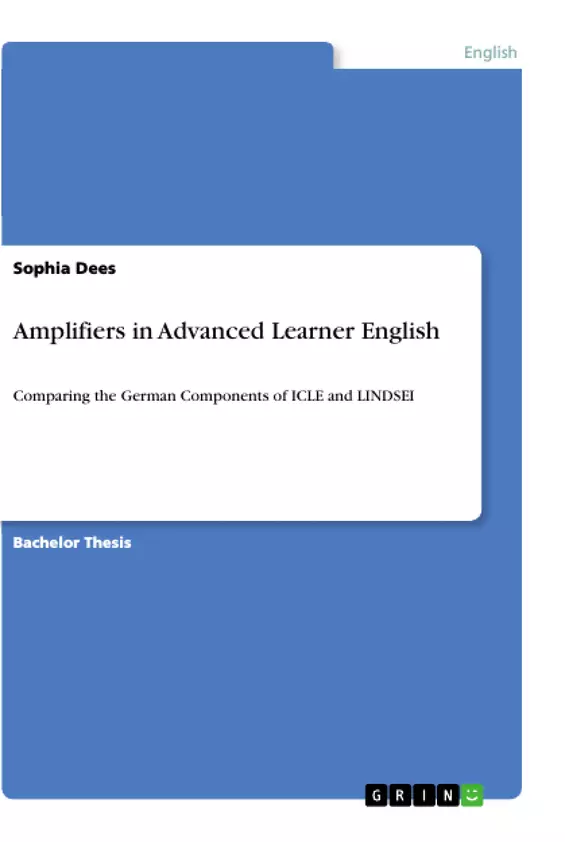Starting with a basic comparison of amplifiers as well as intensifiers in ICLE and LINDSEI, this paper attempts to depict differences of adjective intensification in a written and a spoken context in a more detailed way.
First, the term intensifier is defined and its functions are described. Secondly, the role of intensification in English foreign language teaching is explained, as well as the improvement of linguistic studies with the help of corpora. Following thereupon is the methodological part, which describes the concrete analysis of LINDSEI, with the help of the research toolAntConc. Then the types and tokens of amplifiers as well as intensifiers of ICLE and LINDSEI-GE are compared in order to depict general differences of a written and a spoken context. After that the modified adjectives are examined concerning their overall frequency.
Furthermore, the most frequent adjective-intensifier collocations are exposed. Charts are used to illustrate the results of the study to show mainly absolute numbers. Then the results are discussed and compared to Lorenz' findings with a reference to other studies of this field, such as Sylviane Grangers study of amplifier collocations. Also, problematic aspects erasing while conducting the study and the observation of intensifiers and adjectives are discussed as well.
Inhaltsverzeichnis (Table of Contents)
- Introduction
- Theoretical Concepts
- The Definition of Intensification
- The Features of Intensification
- The Significance of Intensification for Learners
- Different Studies of Intensification
- Methodology
- Research Question: Distribution of Intensification
- Sources Used for the Corpus-based Analysis
- Lindsei Corpus as Analysable Set of Data
- AntConc as Corpuslinguistic Research Tool
- Results and Discussion
- The General Approach of the Study
- Adjectives in the Focus of Intensification
- Observation of the Individual Learners
- The Distribution of Very among the 50 Interviewees
- Conclusion
Zielsetzung und Themenschwerpunkte (Objectives and Key Themes)
This study aims to investigate adjective intensification in spoken English, specifically focusing on amplifiers used by German University students of English. It builds upon the work of Lorenz, who studied adjective intensification in written argumentative essays by comparing native and non-native learners. The study utilizes the Louvain International Database of Spoken English Interlanguage (LINDSEI-GE) corpus to compare spoken data to Lorenz's findings on written data. The primary objective is to analyze the distribution and usage of intensifiers, particularly amplifiers, in spoken English by advanced learners.
- The role of intensification in spoken language
- Differences in intensification between written and spoken corpora
- The impact of intensification on learners' language acquisition
- The use of corpora as a tool for studying language variation
- Comparison of findings with previous research on intensification
Zusammenfassung der Kapitel (Chapter Summaries)
- Introduction: This chapter introduces the concept of intensification and its significance in communication. It discusses how intensification can be used to convey emphasis, persuasion, and influence, highlighting its importance in language learning. The study's focus on spoken English and its comparison to Lorenz's findings on written English is presented.
- Theoretical Concepts: This chapter provides a theoretical framework for the study by defining intensification, its subtypes (amplifiers and downtoners), and its features, including open-class and closed-class items, formal and informal intensifiers, and restricted and wide collocability. The chapter also discusses the role of intensification in language teaching and research.
- Methodology: This chapter describes the research methods used in the study, including the research question, the source of data (LINDSEI corpus), the corpus analysis tool (AntConc), and the specific aspects of intensification under investigation.
- Results and Discussion: This chapter presents the results of the corpus analysis, including an overview of the distribution of intensifiers in the LINDSEI corpus, the frequency of various intensifiers, and a comparison of findings to Lorenz's study. The chapter also discusses the limitations of the study and potential areas for further research.
Schlüsselwörter (Keywords)
This study focuses on the key concepts of intensification, amplifiers, adjective intensification, corpus linguistics, spoken English, learner language, LINDSEI corpus, and AntConc. It examines the distribution and usage of intensifiers, particularly amplifiers, in spoken English by advanced learners. The research aims to contribute to our understanding of the role of intensification in language learning and communication.
- Citar trabajo
- Sophia Dees (Autor), 2016, Amplifiers in Advanced Learner English, Múnich, GRIN Verlag, https://www.grin.com/document/538889



